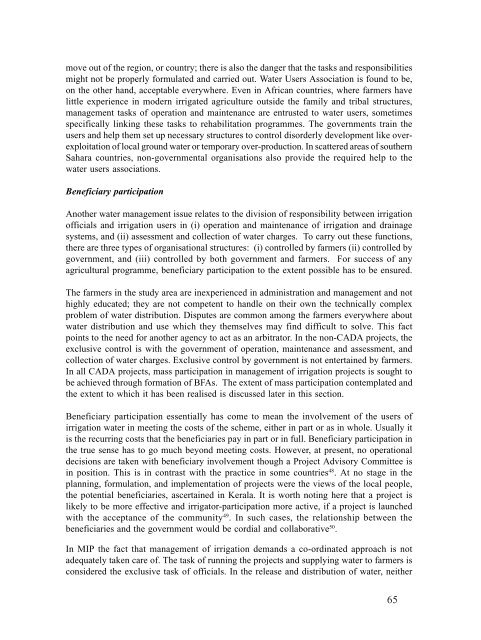Beneficiary Participation in Irrigation Water Management: The Kerala
Beneficiary Participation in Irrigation Water Management: The Kerala
Beneficiary Participation in Irrigation Water Management: The Kerala
Create successful ePaper yourself
Turn your PDF publications into a flip-book with our unique Google optimized e-Paper software.
move out of the region, or country; there is also the danger that the tasks and responsibilities<br />
might not be properly formulated and carried out. <strong>Water</strong> Users Association is found to be,<br />
on the other hand, acceptable everywhere. Even <strong>in</strong> African countries, where farmers have<br />
little experience <strong>in</strong> modern irrigated agriculture outside the family and tribal structures,<br />
management tasks of operation and ma<strong>in</strong>tenance are entrusted to water users, sometimes<br />
specifically l<strong>in</strong>k<strong>in</strong>g these tasks to rehabilitation programmes. <strong>The</strong> governments tra<strong>in</strong> the<br />
users and help them set up necessary structures to control disorderly development like overexploitation<br />
of local ground water or temporary over-production. In scattered areas of southern<br />
Sahara countries, non-governmental organisations also provide the required help to the<br />
water users associations.<br />
<strong>Beneficiary</strong> participation<br />
Another water management issue relates to the division of responsibility between irrigation<br />
officials and irrigation users <strong>in</strong> (i) operation and ma<strong>in</strong>tenance of irrigation and dra<strong>in</strong>age<br />
systems, and (ii) assessment and collection of water charges. To carry out these functions,<br />
there are three types of organisational structures: (i) controlled by farmers (ii) controlled by<br />
government, and (iii) controlled by both government and farmers. For success of any<br />
agricultural programme, beneficiary participation to the extent possible has to be ensured.<br />
<strong>The</strong> farmers <strong>in</strong> the study area are <strong>in</strong>experienced <strong>in</strong> adm<strong>in</strong>istration and management and not<br />
highly educated; they are not competent to handle on their own the technically complex<br />
problem of water distribution. Disputes are common among the farmers everywhere about<br />
water distribution and use which they themselves may f<strong>in</strong>d difficult to solve. This fact<br />
po<strong>in</strong>ts to the need for another agency to act as an arbitrator. In the non-CADA projects, the<br />
exclusive control is with the government of operation, ma<strong>in</strong>tenance and assessment, and<br />
collection of water charges. Exclusive control by government is not enterta<strong>in</strong>ed by farmers.<br />
In all CADA projects, mass participation <strong>in</strong> management of irrigation projects is sought to<br />
be achieved through formation of BFAs. <strong>The</strong> extent of mass participation contemplated and<br />
the extent to which it has been realised is discussed later <strong>in</strong> this section.<br />
<strong>Beneficiary</strong> participation essentially has come to mean the <strong>in</strong>volvement of the users of<br />
irrigation water <strong>in</strong> meet<strong>in</strong>g the costs of the scheme, either <strong>in</strong> part or as <strong>in</strong> whole. Usually it<br />
is the recurr<strong>in</strong>g costs that the beneficiaries pay <strong>in</strong> part or <strong>in</strong> full. <strong>Beneficiary</strong> participation <strong>in</strong><br />
the true sense has to go much beyond meet<strong>in</strong>g costs. However, at present, no operational<br />
decisions are taken with beneficiary <strong>in</strong>volvement though a Project Advisory Committee is<br />
<strong>in</strong> position. This is <strong>in</strong> contrast with the practice <strong>in</strong> some countries 48 . At no stage <strong>in</strong> the<br />
plann<strong>in</strong>g, formulation, and implementation of projects were the views of the local people,<br />
the potential beneficiaries, ascerta<strong>in</strong>ed <strong>in</strong> <strong>Kerala</strong>. It is worth not<strong>in</strong>g here that a project is<br />
likely to be more effective and irrigator-participation more active, if a project is launched<br />
with the acceptance of the community 49 . In such cases, the relationship between the<br />
beneficiaries and the government would be cordial and collaborative 50 .<br />
In MIP the fact that management of irrigation demands a co-ord<strong>in</strong>ated approach is not<br />
adequately taken care of. <strong>The</strong> task of runn<strong>in</strong>g the projects and supply<strong>in</strong>g water to farmers is<br />
considered the exclusive task of officials. In the release and distribution of water, neither<br />
65










